Introduction
Knowing how to check tire pressure is one of those tiny habits that pay off big in safety, fuel economy, and tire longevity. If you’ve ever wondered how to check tire pressure without second-guessing yourself, you’re in the right place. In the next few minutes, you’ll learn how to check tire pressure the right way—so you can spot issues early, avoid blowouts, and keep your car feeling planted and predictable on the road.
Most drivers guess by eye, but learning how to check tire pressure with a gauge gives you real numbers you can trust. Tires naturally lose a little air each month, and a 3–5 PSI drop can reduce grip, add stopping distance, and wear the shoulders prematurely. When you know how to check tire pressure on a cool tire, you’ll get accurate readings, compare them to the sticker in your door jamb, and top up only what’s needed.
We’ll also cover when and why to test: morning checks, seasonal shifts, long road trips, and after temperature swings. By mastering how to check tire pressure, you’ll save money at the pump and extend tread life. You’ll also learn what affects PSI—ambient temperature, load, speed, and driving style—so you can spot patterns and adjust confidently.
Finally, we’ll make “how to check tire pressure” effortless: the tools to keep in your glove box, the ideal PSI ranges, and a step-by-step walkthrough that demystifies the whole process. Whether you use a pencil-style, analog, or digital gauge, you’ll finish with a reliable routine you can repeat in two minutes flat. If you’re teaching a new driver, show them how to check tire pressure before every weekend drive.
This guide keeps things practical: you’ll see what numbers to expect in everyday cars and SUVs, how temperature can drop PSI overnight, and why checking before driving matters. We’ll explain the door-jamb sticker versus the sidewall max, what “cold tire” actually means, and how to avoid the common mistake of over-inflating after a highway run. You’ll also get quick tips for run-flats, TPMS warnings, and compact spares, plus a simple logging template so you can track PSI trends over months and spot a slow leak before it becomes a roadside headache.
Tools & Gauges You Need
Before you master how to check tire pressure, you’ll need the right tools to ensure accurate readings. The most essential tool is a tire pressure gauge, which comes in three main varieties: pencil-style, analog dial, and digital. Each gauge has its pros and cons. A pencil gauge is cheap and durable, while a dial gauge gives clearer readings, and digital gauges are the easiest to read. Knowing which one to trust makes learning how to check tire pressure much smoother.
Digital gauges, in particular, are highly recommended if you’re serious about precision. They light up in low-light conditions and remove any guesswork from the reading. When you’re learning how to check tire pressure, accuracy matters because even a 1–2 PSI difference can impact handling, comfort, and tire wear. Analog gauges are reliable too, but they may require calibration over time. If you drive often in cold mornings or late evenings, a backlit digital gauge simplifies the process.
A reliable air compressor is the second must-have tool. While most gas stations have air pumps, investing in a portable unit that plugs into your car’s 12V outlet saves time and keeps you prepared. This way, after you check tire pressure, you can top up immediately without hunting for a station. Pairing a gauge with a portable compressor makes it easy to follow through once you know how to check tire pressure properly.
Other handy accessories include valve stem caps (with built-in pressure indicators if you prefer visual checks), a notebook or phone app for recording PSI, and gloves to keep your hands clean. If you’re teaching someone else how to check tire pressure, showing them how to log numbers in a simple chart helps track slow leaks or seasonal changes. Over time, this creates a pattern that tells you if one tire consistently loses air faster than the others.
Lastly, consider a tire inflator with an automatic shutoff feature. This prevents accidental over-inflation when you’re still learning how to check tire pressure and adjust it correctly. A small LED flashlight also helps if you often check your tires before sunrise or after work. With this basic kit—a gauge, compressor, and logging method—you’ll never have to rely on rough guesses again. You’ll feel confident that you not only know how to check tire pressure but can correct it anytime, anywhere.
Ideal PSI by Season & Load
Once you’ve learned how to check tire pressure, the next step is knowing what number to aim for. PSI, or pounds per square inch, varies depending on your vehicle, the season, and how heavily you’re loading your car. The golden rule is to follow the manufacturer’s recommendation, usually found on a sticker inside the driver’s door or in your owner’s manual. If you understand how to check tire pressure against these values, you’ll ensure optimal performance and safety.
Cold weather plays a huge role in tire pressure. For every 10°F drop in temperature, your tires can lose about 1 PSI. This means that in winter, even if you know how to check tire pressure, you’ll likely notice consistent drops that need correction. Checking first thing in the morning, when the tires are cold, gives the most accurate reading. In summer, the opposite can happen—heat builds pressure, and drivers often forget that a reading after a highway drive will be artificially high. Knowing how to check tire pressure cold versus hot is key.
Load also changes the equation. If you’re towing a trailer, carrying heavy cargo, or heading out on a long road trip with the family, the recommended PSI may increase. Many manufacturers provide a “loaded” tire pressure number. By practicing how to check tire pressure before you leave, you’ll prevent sidewall flex, uneven wear, and dangerous overheating. This step is especially important for SUVs, vans, and trucks that often handle variable loads.
Another nuance is the difference between front and rear tires. Some vehicles, especially performance models, require different PSI levels for balance and stability. When you learn how to check tire pressure, pay attention to whether the sticker lists separate numbers. Don’t rely on the tire sidewall maximum—this is not the recommended daily PSI but the safe limit under maximum load. Using that number can make the ride harsh and reduce traction.
Finally, seasonal transitions are the best time to reset habits. Before winter hits, test your knowledge of how to check tire pressure and adjust accordingly. Before summer road trips, do the same. This routine ensures you’re not surprised by TPMS (Tire Pressure Monitoring System) warnings. With experience, you’ll be able to anticipate when changes in weather or driving conditions mean it’s time for a quick check. That way, how to check tire pressure becomes second nature in your car-care routine.
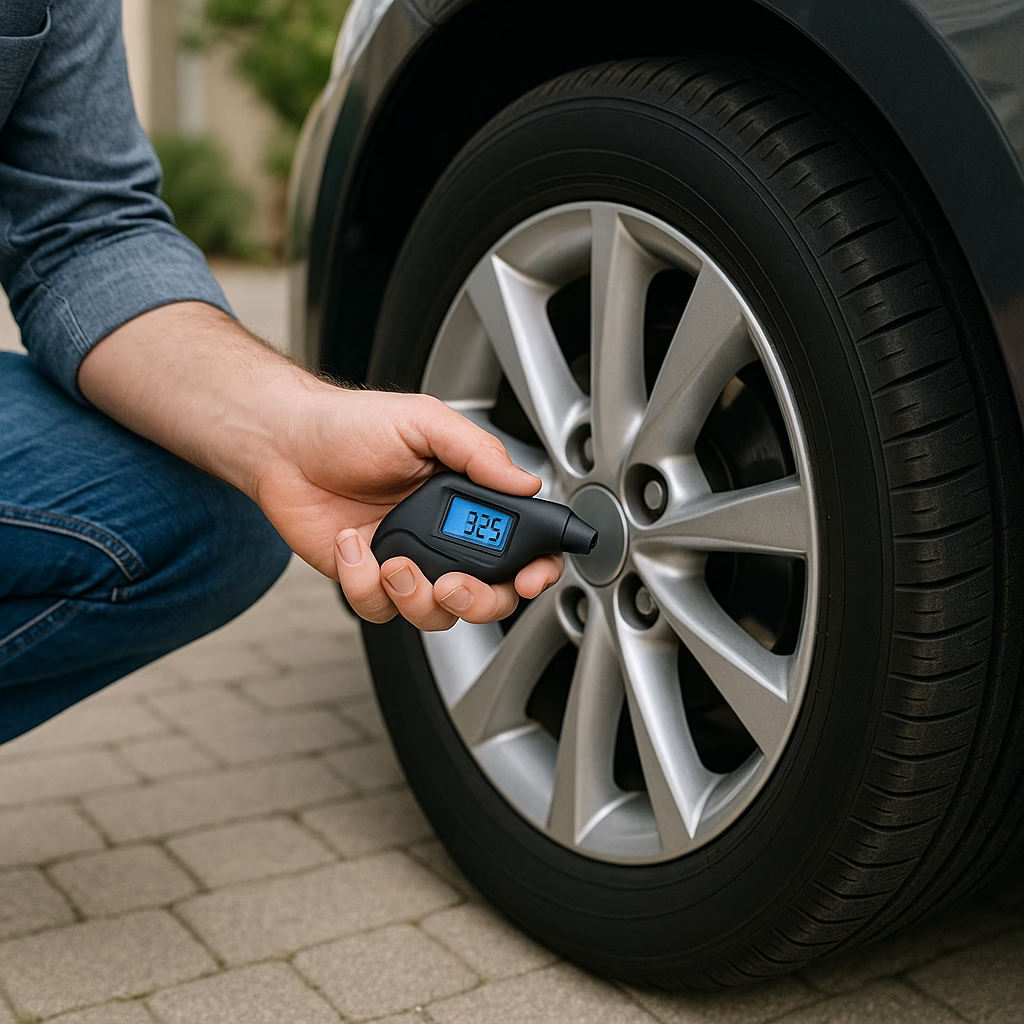
Step-by-Step: How to Check Tire Pressure
Now it’s time to walk through exactly how to check tire pressure. This process is simple, but accuracy depends on following the right order. Even if you’ve never done it before, after practicing these steps, you’ll know how to check tire pressure in under two minutes per tire. Keeping your tires properly inflated protects you from blowouts, improves fuel economy, and makes every drive safer.
Step 1: Prepare Your Tools
Start by gathering a tire pressure gauge and, if needed, a portable air compressor. Learning how to check tire pressure requires consistency, and having tools ready ensures you don’t skip checks. Do this on “cold tires”—meaning the car has been parked for at least three hours. This eliminates false readings caused by heat expansion.
Step 2: Remove the Valve Stem Cap
Find the valve stem on your tire and twist off the cap. Keep it in your pocket so you don’t lose it. Many beginners learning how to check tire pressure misplace caps, but replacing them helps protect the valve from dirt and moisture. A missing cap won’t ruin your tire, but it can shorten valve life.
Step 3: Press the Gauge Firmly
Place the gauge evenly on the valve stem and press firmly to avoid hissing. If you hear a rush of air, you didn’t seal it correctly—try again. This is a common mistake when first learning how to check tire pressure. Once sealed, the gauge will give you an immediate reading. Digital gauges display it clearly, while analog or pencil types show it on a dial or sliding scale.
Step 4: Compare with Recommended PSI
Look at the sticker inside your driver’s door or the manual. Compare your reading. If it’s lower, add air using your compressor; if it’s higher, press the valve stem briefly to release air. This step is where knowing how to check tire pressure really saves your tires from uneven wear and wasted gas.
Step 5: Replace the Valve Cap and Repeat
Once adjusted, replace the cap tightly and move on to the next tire. Be sure to check all four tires—and don’t forget the spare if your car carries one. By making this part of your monthly routine, how to check tire pressure turns from a chore into a quick habit that adds years to your tire life.
That’s it—you’ve learned how to check tire pressure step by step. Practice this monthly, before long trips, and after big temperature swings. Over time, the process becomes automatic, and you’ll wonder how you ever relied on guesswork.
Troubleshooting & Common Mistakes
Even after you know how to check tire pressure, mistakes can happen. Many drivers assume they’re doing it correctly but end up with inaccurate readings or uneven inflation. Understanding the most common pitfalls will make your routine smoother and give you confidence every time you test. By recognizing these errors, you’ll ensure your knowledge of how to check tire pressure always leads to safe and reliable results.
One frequent mistake is checking tires immediately after driving. Heat builds pressure, which inflates readings by several PSI. If you know how to check tire pressure correctly, you’ll wait until the tires are cold—ideally first thing in the morning. Another error is comparing your gauge reading to the sidewall number. That figure is the maximum load capacity, not the recommended everyday PSI. Knowing how to check tire pressure means trusting the door-jamb sticker instead.
Another common issue is relying solely on the TPMS (Tire Pressure Monitoring System). While convenient, TPMS sensors often trigger only when pressure drops significantly. Learning how to check tire pressure with a gauge gives you a much more accurate snapshot. Many drivers discover that their tires are 2–3 PSI low without any dashboard warning. This small gap can impact braking distance and fuel economy over time.
Over-inflation is another hazard. Some people top off their tires until they “look” right, but looks are deceptive. If you know how to check tire pressure, you’ll avoid the stiff ride, reduced traction, and increased wear that come from pumping in too much air. Always add in small increments, recheck, and adjust gradually. Similarly, don’t forget the spare—many roadside delays happen because the spare was neglected for months or years.
Finally, be mindful of gauge accuracy. Cheap gauges can wear out, and even digital ones may lose calibration. If you’re serious about how to check tire pressure, consider replacing your gauge every few years or testing it against a professional compressor. This ensures you’re not making decisions based on faulty data. With these troubleshooting tips, you’ll refine your process, avoid rookie errors, and turn how to check tire pressure into a failproof routine that keeps your vehicle safe.
FAQ
Even after learning how to check tire pressure, many drivers still have small questions. This FAQ clears up the most common ones and helps make your routine simple and stress-free.
How often should I check my tire pressure?
Experts recommend practicing how to check tire pressure at least once a month and before long trips. Seasonal changes in temperature can cause drops, so extra checks during fall and winter are especially useful.
Can I rely only on my TPMS warning light?
Not completely. While TPMS is helpful, it often alerts only after a significant drop. By knowing how to check tire pressure manually with a gauge, you’ll catch small issues before they become bigger safety concerns.
Do I need different PSI for front and rear tires?
Sometimes, yes. Many vehicles list separate PSI numbers for front and rear on the driver’s door sticker. When you learn how to check tire pressure, be sure to compare each tire against the right value instead of assuming all four should match.
Is there a best time of day to check?
Morning is best. Checking on cold tires gives the most accurate reading. Heat from driving or sun exposure can inflate PSI readings. Practicing how to check tire pressure before your first drive of the day eliminates that variable.
What if my gauge reading doesn’t match the gas station pump?
This happens often due to calibration differences. Trust your personal gauge, especially if it’s high quality. By knowing how to check tire pressure consistently with the same tool, you’ll build reliable results even if public pumps vary slightly.
Do spare tires need to be checked too?
Yes. Many spares sit unused for years, and when finally needed, they’re flat. By including the spare when you practice how to check tire pressure, you’ll avoid delays and frustration during an emergency roadside change.
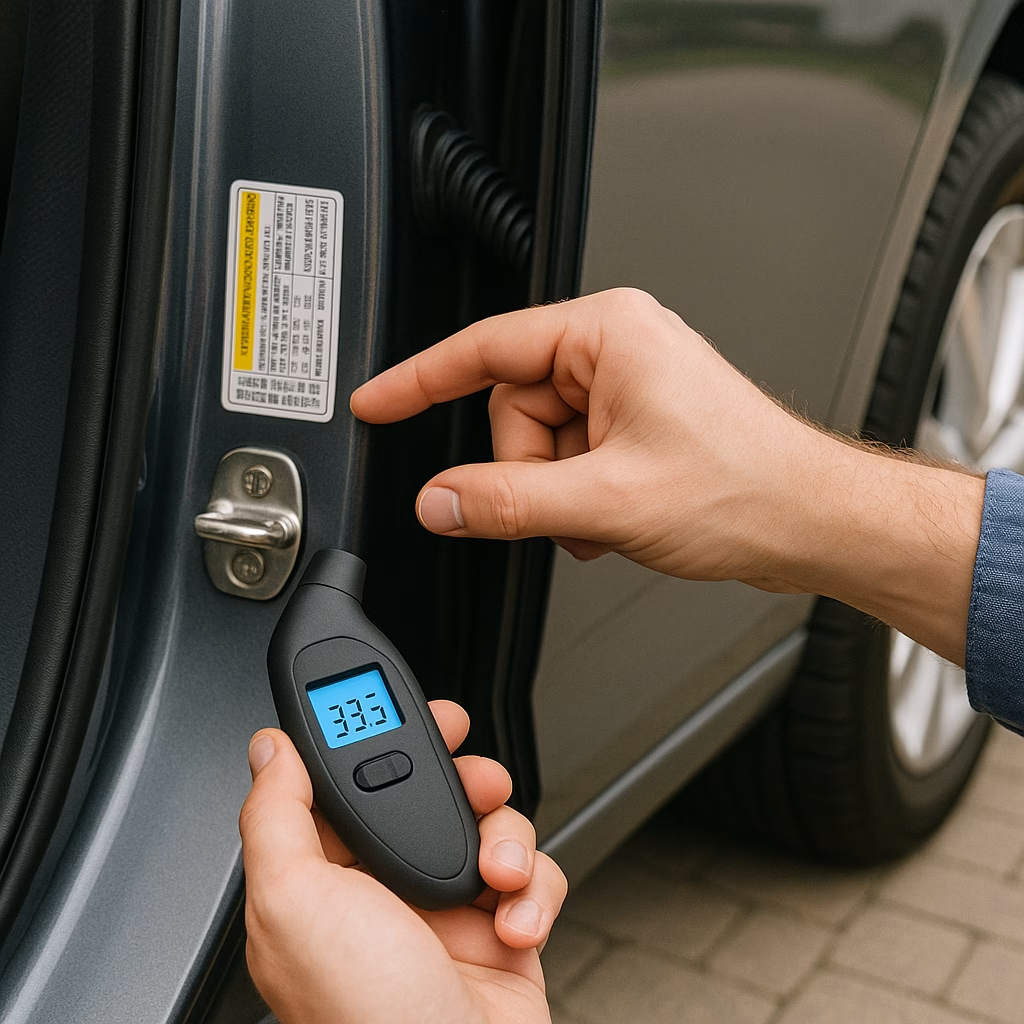
Conclusion
By now, you’ve seen that mastering how to check tire pressure is more than a quick chore—it’s a safety habit that pays dividends every mile you drive. From choosing the right gauge to understanding seasonal PSI shifts, you’ve built the knowledge to spot problems early and adjust with confidence. Whether you’re teaching a new driver or refreshing your own skills, knowing how to check tire pressure empowers you to keep your vehicle safer, your fuel costs lower, and your tires lasting longer.
The real advantage of learning how to check tire pressure is consistency. Make it a monthly ritual, and add it to your pre-trip checklist before vacations or heavy-load hauls. This way, you’ll never be caught off guard by a sudden TPMS warning or a sluggish tire that eats into your gas mileage. Even better, you’ll avoid the uneven wear patterns that cost money in premature replacements. Regular checks protect your investment in your tires and give peace of mind for every passenger on board.
Don’t overlook the power of simple record-keeping. By logging your PSI results, you can detect slow leaks, spot a failing valve stem, or confirm that a tire repair is holding. Knowing how to check tire pressure isn’t just about inflating or deflating—it’s about seeing patterns that hint at larger maintenance needs. Over time, these small notes can help you predict when a tire rotation, alignment, or replacement is due.
In short, the process of how to check tire pressure takes just minutes but adds layers of safety, savings, and driving confidence. You don’t need advanced mechanical skills—just a gauge, a compressor, and a few minutes of attention. With practice, the steps become automatic, and your tires will reward you with longer life, smoother rides, and greater reliability. Keep this routine simple, stick to it, and enjoy the confidence that comes with truly understanding how to check tire pressure.
Read Similar Topics
External Resources
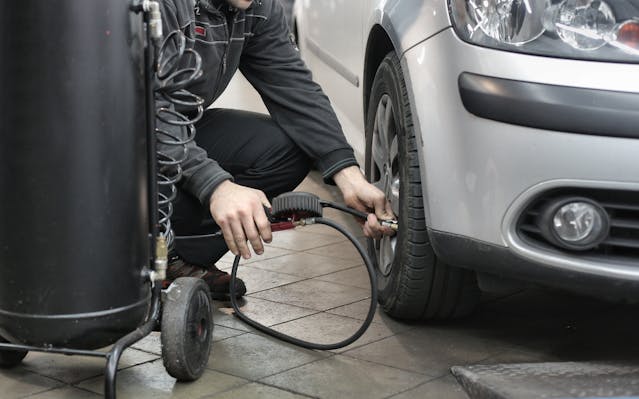
Share this:
- Click to share on Facebook (Opens in new window) Facebook
- Click to share on X (Opens in new window) X
- Click to share on LinkedIn (Opens in new window) LinkedIn
- Click to share on Reddit (Opens in new window) Reddit
- Click to share on X (Opens in new window) X
- Click to share on Threads (Opens in new window) Threads
- Click to share on WhatsApp (Opens in new window) WhatsApp

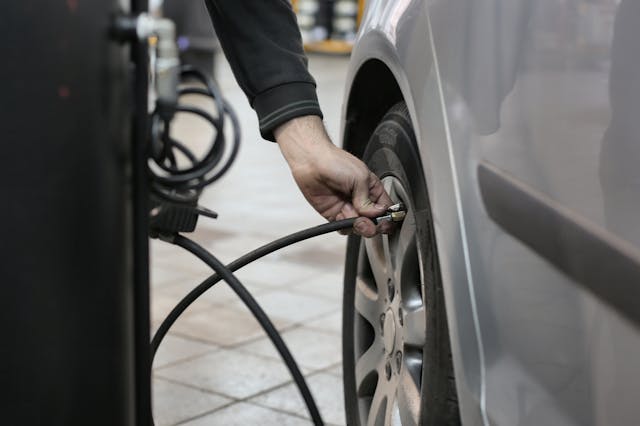

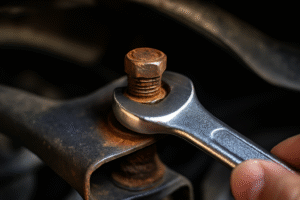

Pingback: How To Check Car Alignment Easily – Proven DIY Guide
Pingback: How To Check Coolant Levels Safely – Essential Car Care Guide
Pingback: How To Cook Chicken Breast Without Drying It Out – Proven Guide